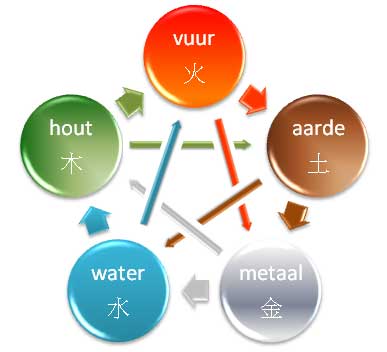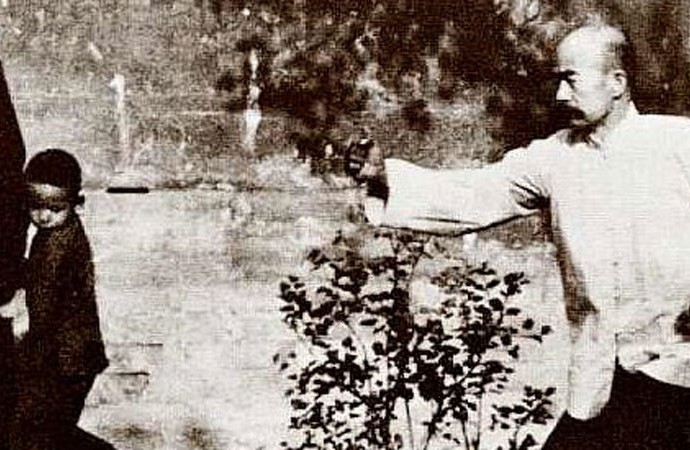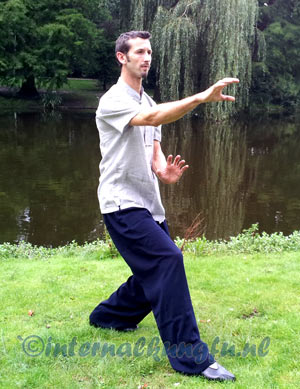The Chinese are not a People who give names to something for no reason. Entrusting the core base 5 techniques of your system with the name 5 elements/ Wu xing五行, is not just a philosophical spoof. I believe that, these basics of XingYi can provide a bigger view and insight of oneself, life, than mere self-defense. It will drastically change your way of practice. This is something I like to bring forward in my teaching.
Al ot of people like to play with Wu xing on a very basic level. They’re focus is on the Ke- and Sheng cycle (constructive and destructive cycle). Especially bec ause XingYi is a martial art the Ke-cycle is emphasized. You can read all kinds of translations for the “Ke” character: destroying, attacking,… .
ause XingYi is a martial art the Ke-cycle is emphasized. You can read all kinds of translations for the “Ke” character: destroying, attacking,… .
To the best of my knowledge and understanding “controlling” is the best translation. The Wood face controls the Earth fase, which in turn controls the Metal fase and so on. Controlling… , more in the sense of making it possible for the other fases to manifest themselves in an orderly, balanced way. In XingYi this manifests itself as Pi Chuan being able to stop/break Beng Chuan and so on. (“Pi” is done like slapping/splitting down with the palm, “Beng” is done like continuous punching forward) These provide easy to understand basic attacking defending idioms.
The former view is, of course, very interesting but when you get stuck on this level of understanding you will not reap the same benefits as someone who takes it a step further.
Wu Xing talks about 5 energies or fases which constitute a whole in which there is a never ending progression of one fase/enegy in to the other. It’s the overall principle of life on this earth and its your basic training in XingYi! By consequence you can understand life better by practicing the language of 5 elements expressed in XingYi. Some understand it through Chinese medicine, some through philosophy… we do it through XingYi: Through physical practice!
Gaining insight in the separate parts can make you understand the whole better. I personally don’t like to see someone playing Wu Xing on a monotone level. These are very different elements who should be preformed differently and I’m not just talking about outward appearance. Remember the translation of “XingYi”; meaning to form/mind boxing, thus connecting your movements with an intention of the mind. The whole intention when you play Pi Chuan should differ from Beng Chuan. Otherwise its all the same. And if these 5 elements are the true building blocks of XingYi and I mean THERE’S JUST 5 of them! Shouldn’t they be at least looked at closely and differently and from as much angles as possible (which is a very Chinese thing to do).
“Remember the translation of “XingYi”; meaning to form/mind boxing, thus connecting your movements with an intention of the mind.”
Now let’s think about the wood fase for example. What could you do to implement the “feel” of this fase to your performance of Beng chuan? To do this it’s interesting to look at what the wood fase represents, what does it have to contribute to the 5 elements as a singularity and as a whole?
You can find plenty information on the attributes on the internet but let’s name a few to get a picture:
• Springtime
• Wind
• Planning ahead
• Frustration/anger
• Liver/gallbladder
• renewal, reawakening and rebirth
• seedlings
• bow and arrow
• flexibility and ability to change necessarily for survival
• upward movement
• …
Now what does this tell you and what is the relation between your practice and the difference in-between the other elements. If the Chinese placed your Beng chuan within the framework of Wu Xing and pertaining to the Wood fase (the Wood fase does not pertain to Beng chuan btw) what link is here to be seen? The key is to see the common principle uniting these loose words and movements.
(You can understand that by looking at XingYi in this way it goes far beyond the word “sport” and that you do not train XingYi but study it!!! It’s a lifetime’s work because understanding is not the same as being able to do it.)
So what do we see as a common principle? There is an element of starting growth from the depth that is unstoppable and this uprising of sudden yang energy shoots straightforward. If you try to stop it it will change its path slightly to progress again. This movement is forward not back. There is also a tension that comes along with this starting from scratch, just as you would watch a bird coming out of an egg. It’s the moment just before the egg gets punctured by the beak and the actual breaking of the egg. The stopping of this inevitable movement creates tension and frustration.
This is very different from the Water fase principle which precedes the Wood fase in the Sheng cycle. How to do the movement? This is something you will have to ask your teacher, words fall short to seeing and feeling…
The bigger forms in XingYi like Wuxing he yi, lian huan, Ba shi, zha shi chui, … all derive their elemental strength out of the basic five elements. Just as the 12 meridians are preceded by the 5 elements in Chinese medicine, you could say that the 12 meridians are a step further, going more in to detail. There is a reason why you first learn 5 elements separate and then bigger forms. You should be able to switch quickly in between the different energies of the 5 elements because the bigger forms are successions of the 5 elements fists. You have to be skilled to identify the 5 elements’ feel in other movements that don’t look the deal but are essentially the same. This will add quality to your form and is proof of diligent study and understanding.
Words are in no way a replacement for practice so the only way to put this text in to use is to practice experience and feel. Enjoy!
If you liked what you read check out the rest of the blog.
Especially understanding XingYi part I
Xingyi wordt in Haarlem en Amsterdam gegeven.
Hier vind je meer info over lestijden, prijzen en locaties.
Ps: Some interesting questions/angles I didn’t address are: what is the relationship between let’s say the Pi chuan and the lung organ who both belong to the summarizing whole of the Metal fase and Why does training Pi chuan in a wrong fashion have a bad effect on the lungs (maybe even digestion?) Maybe for a later blog 😉
Ruud Vercammen is a licensed Acupuncturist and Tuina therapist. He teaches XingYi and BaguaZhang In Amsterdam and Haarlem. You can also find him on Linkedin
Ruud is available for workshops where the link between Chinese callisthenics, medicine, philosophy and daily life will become apparent and helpful for all.



